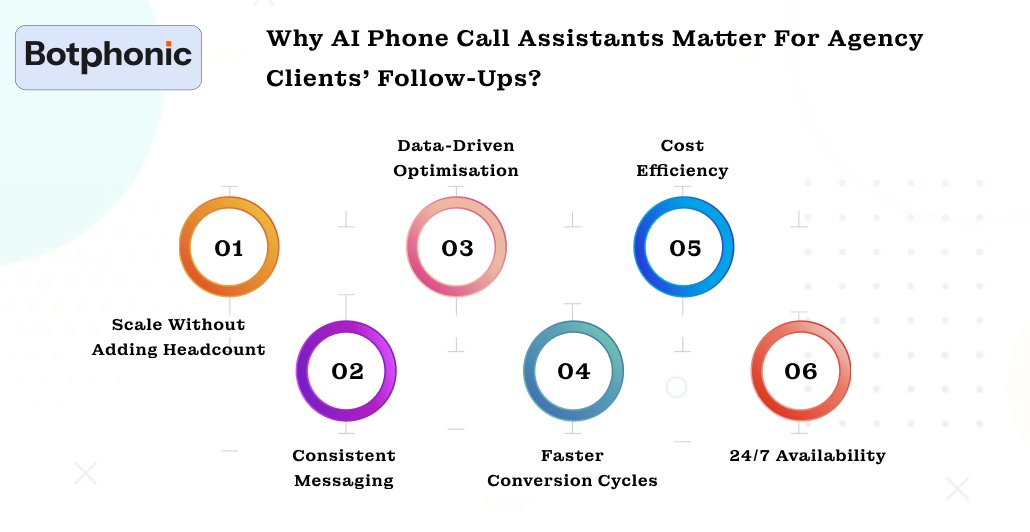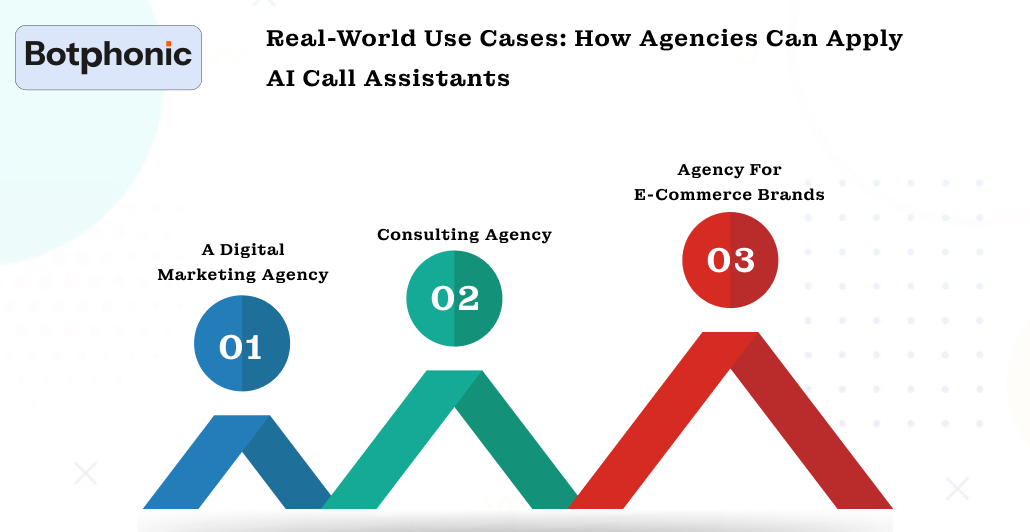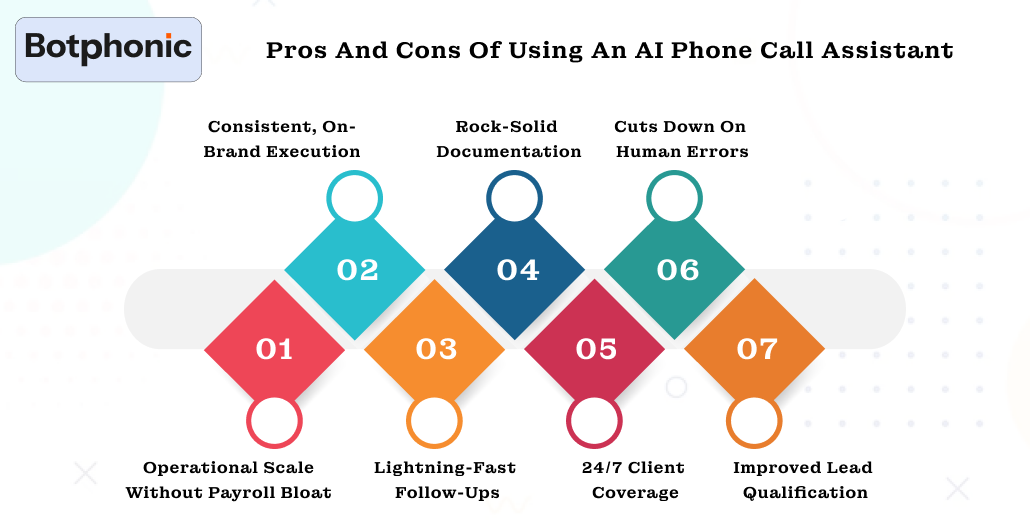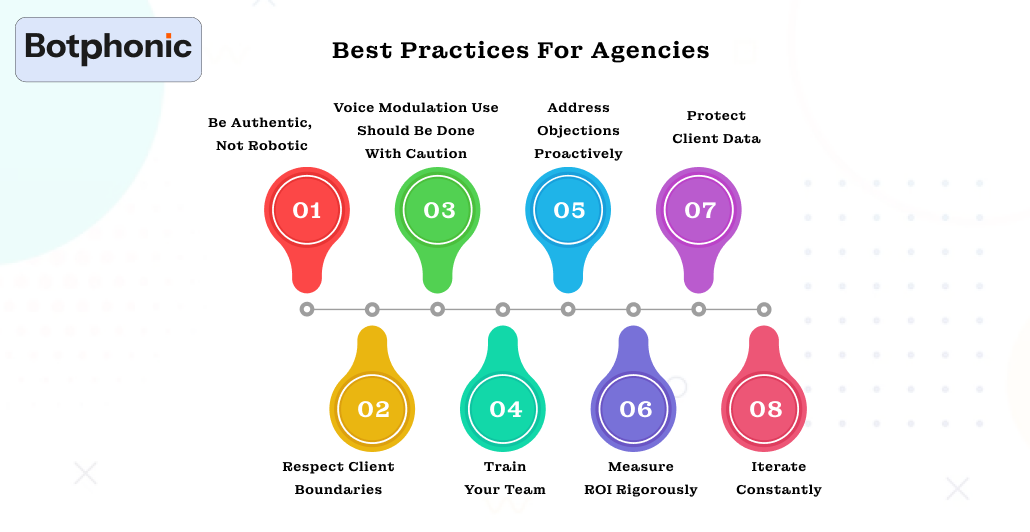
Summarize Content With:
Quick Summary
In this blog, we’ll explore how AI sales phone call assistants can easily revolutionize your agency’s follow-up strategy, checking real-world use cases, and offer actionable advice for you. We might also compare different tools and answer some of the most asked questions to clear all your doubts regarding the AI phone call assistant.
Introduction
Imagine this: You have started a marketing or consulting agency. You have just provided a successful pitch. And you are even confident that your client is interested, but they haven’t committed to you yet. The time is passing by, and follow-up emails have gotten lost in the sea of a busy inbox. Calls might have been missed, and your momentum has been sputtered. And here’s when you think, Wish you had an assistant for client follow-up. And just so you know, today we are going to discuss an AI phone call assistant for client follow-ups that’s going to be your secret weapon from today onwards.
Clients’ expectations are growing rapidly; they are just looking for responsiveness and personalization. Yet there are agencies that often struggle to maintain this consistency and offer high-touch engagement at scale. Traditional approaches, such as manual dialing, note-taking, and follow-up scheduling, are tasks that are really time-consuming, error-prone, and inefficient.
Let us tell you about AI phone call technology. These are smart systems that automate outbound calls, analyze conversations, and even adapt to messaging based on customers’ intent. With the right AI call assistant, your agency can just follow up faster and get better insights. Moreover, you will get all these while freeing up your team to focus on creativity, strategy, and even relationship building.
Uncovering an AI Phone Call Assistant
An AI phone call assistant is definitely a software system that is powered by artificial intelligence that can easily:
- Place and accept phone calls on behalf of a human agent.
- Acknowledges and shares responses to spoken language that uses NLP.
- Transcribes conversations in real-time.
- Dissects and understands the conversations for sentimental, talk-time, customer intent, and even key topics.
- Automates follow-ups, schedules call-backs, or even sends summary notes to the team.
Rather than simply acting like a chatbot, an AI call assistant can easily mimic human-like voice interactions. Easily navigates branching conversations and even escalates to live agents when it’s required.
Why AI Phone Call Assistants Matter for Agency Clients’ Follow-Ups?

Let’s check out some of the strategic advantages that agencies get for integrating AI phone call assistants. AI phone call assistants are not just bells and whistles for clients, but they are one of the most practical and ROI-driven tools. Here’s why:
1. Scale Without Adding Headcount
Companies will just have to forget about hiring more junior staff just for handling some calls. AI can easily manage hundreds of follow-ups at once without even requiring any coffee breaks or sick days. The workforce has been simply multiplied overnight.
2. Consistent Messaging
Humans are simple creatures; they are bound to get distracted, tired, or even sometimes awkward on the phone. Whereas AI is made with precision that delivers your brand’s voice without any mistake every single time. There won’t be any off-brand improvisation, no missed points with a pre-designed script.
3. Data-driven Optimisation
With AI call assistant, every call is tracked, analyzed, and logged automatically. You instantly see who’s responsive and what objections are coming up. Moreover, it also helps by predicting which clients might need human touch next. And that’s one of the most intelligent acts that can be performed without requiring any old spreadsheet.
4. Faster Conversion Cycles
Clients are getting responses as quickly as possible, and most importantly, it’s definitely not taking days or weeks just to get an answer. Speed is something that’s getting people’s attention today. AI helps keep the pipeline hot while agents are focusing on stuff that actually requires thinking.
5. Cost Efficiency
Companies now have to spend less time on training, and there will definitely be fewer dropped calls. With fewer errors and fewer payroll, the numbers will speak for themselves.
6. 24/7 Availability
With this AI phone call assistant, follow-ups happen even outside business hours. Helping catch clients when they are actually free.
If your company’s goals are predictable, such as revenue, operational efficiency, and even a modern agency workflow, AI call assistants are a tactical necessity.
How AI Phone Call Assistants Work: A High-Level Overview
At a high level, the mechanics are just straightforward, even if its underlying tech is doing acrobatics behind the scenes. Let’s see the big-picture view of how these systems actually get the job done:
1. Intake and Triggering
When the customer reaches a particular step in the pipeline, be it a missed call, completion of a form or simply a neglected proposal, the virtual assistant will come into action without any delay. There won’t be any pauses or inquiries like, “Has this client been followed up by anyone?” The system will just continue on its own.
2. Dynamic Script Generation
Instead of just sticking to a script like an intern, the assistant will pull up from approved messaging, brand tone, and historical call outcomes. It effectively tailors the conversations, that is based on context, not just guesswork. Just think of it as an old-school consistency that’s blended with modern adaptability.
3. Real-Time Conversation Handling
The assistant is mimicking human speaking mode, taking, and replying in real-time. Not that kind of robotic voice that was prevalent in the early 2010s. It translates the meaning of the words, objection, and keeps the conversation on track, but without the small talk that no one wants.
4. Smart Routing & Escalation
Once a client indicates that he is ready, annoyed, confused, or valuable, the system will immediately transfer him to a human representative. No pride, no awkwardness. Just smooth handovers that are friendly and maintain the sales process.
5. Automatic Logging & Insight Capture
All interactions are recorded in a very precise manner. You receive call quick reviews, sentiment indicators, next moves, and flags for caution all inside your CRM and all in an organized way. This is the operational cleanliness that most departments hope to have but can seldom maintain.
6. Continuous Improvement Loop
The assistant is a student of the results. What brings deals to a close? What drives them away? Which objections are irrelevant? Its tone, timing, and phrasing are gradually refined. So you enjoy small but steady gains without bothering your team with endless training cycles.
In short, it’s just a disciplined and tireless follow-up machine. Moreover, it also respects the basics of good client communication while leveraging the horsepower of modern automation.
Real‑World Use Cases: How Agencies Can Apply AI Call Assistants

Case Study 1: A Digital Marketing Agency
Challenge: The business development team of a rapidly growing digital marketing agency was overloaded and as a result, they could not keep up with the lead follow-up after the proposal stage. Some leads did not get any callbacks for weeks; others got standard emails.
Solution: They used an AI call assistant which automatically called the prospects 48 hours after the proposal was sent, leaving a personalized voicemail if nobody answered or connecting to a person when someone answered.
Results: The transition they saw was 25% increased lead follow-up made within a day. in three months. The AI called up the summaries in the company’s CRM and pointed out the cost objections and the names of the decision makers. This made the account managers much more prepared for their next outreach.
Case Study 2: Consulting Agency
Challenge: A consultancy that provided high-value B2B services was faced with a long sales cycle. They had to qualify the leads, follow up on the proposals, and build the relationships, but they did not want to exhaust the senior consultants’ time.
Solution: They chose a call automation platform that was based on AI and could perform functions such as booking calls, asking qualifying questions (“What is your budget? Who else is involved in the decision?”), and routing warm leads to senior consultants.
Results: Manual qualification was cut down by 60%. Senior consultants dealt with only those prospects who were qualified and engaged. Their conversion from “proposal sent” to “closed” improved by 25%.
Case Study 3: Agency for E‑Commerce Brands
Challenge: An agency handling e-commerce clients planned to collect feedback after onboarding, guarantee continuous satisfaction, and sell more services, but manually doing that was time-consuming.
Solution: An AI sales phone call assistant was deployed to make calls to the onboarded customers and check on them. The AI was asking standard questions, collecting information, and alerting about the signs like “help with ads needed” or “budget limits.”
Results: The agency revealed numerous (i.e., extra advertising budget, creative services) upselling chances that would have been missed otherwise. Customer satisfaction ratings went up, and the rate of losing customers decreased.
Key Features and Capabilities of Top AI Phone Call Assistants
| Feature | Why It Matters for Agency Follow‑Ups |
| Natural-sounding voice | Makes calls feel human and trustworthy rather than robotic. |
| Speech-to-text & transcription | Provides real-time transcripts for review, CRM notes, and compliance. |
| Real-time intent detection | Captures key signals (“budget,” “decision maker”) to guide follow-ups. |
| Sentiment analysis | Helps assess how positively or negatively a prospect feels, so you can tailor messaging. |
| Scripted or dynamic conversation flow | Lets you define structured scripts or let the AI adapt based on responses. |
| Call recording & storage | Regulatory or quality assurance needs demand recordings; you can repurpose them for coaching. |
| Automated scheduling & follow-up | Automatically books, sends emails, creates reminders, or connects to human agents. |
| CRM integration | Syncs call data, summaries, decisions, and follow-up tasks directly into your CRM. |
| Analytics & reporting | Dashboards to track call volume, conversion trends, objection themes, and more. |
| Voice modulation / AI voice changer | (Optional) Helps vary voice tone or persona when making calls at scale. |
| Machine learning feedback loop | Improves over time by learning which scripts or responses work best. |
Pros and Cons of Using an AI Phone Call Assistant

Using an AI call assistant can be tricky, even though it’s filled with benefits, but every coin has two sides. While it comes with huge upsides there are also some trade-offs. Let’s get the balanced view of the same:
Pros
1. Operational Scale Without Payroll Bloat
You are able to increase your calling capability overnight without even hiring a single junior staff member. It was exactly this kind of efficiency that operations managers from previous generations always fantasized about.
2. Consistent, On-Brand Execution
There is no fatigue, no unscripted moments, and no saying “Excuse me, I forgot to tell you that part.” The assistant replicates your communication like a veteran sales rep who knows the company’s standard operating procedures extremely well.
3. Lightning-Fast Follow-Ups
The time factor is the winner in a deal. AI makes the call right away instead of “when it is convenient for someone to do it.” This alone can result in a considerable change in the speed of your pipeline.
4. Rock-Solid Documentation
What you get are neat summaries, outcomes recorded, and well-maintained CRM updates; all of them. You do not have to find your team for their notes. There is no uncertainty.
5. 24/7 Client Coverage
It is as if your agency is always present at the different locations all day long, but without having your staff act like zombies. Your conversations remain active even through the night, on weekends and holidays, etc.
6. Cuts Down on Human Errors
There will be no mistakes in interpreting, no errors in typing, and no inadvertent commitments made by someone who shouldn’t have. The computer does it without any emotions.
7. Improved Lead Qualification
It distinguishes the serious buyers from the browsers, thus saving your sales force from spending their energy on “Just curious” chats.
Cons
1. Not a Fit for Sensitive, High-Stakes Conversations
Real people are still needed for such cases, angry customers, complicated requirements, or discussions full of subtleties. The assistant is aware of where it is correct to be, but that area is not everything.
2. Voice Tech Can Still Feel… Well, Techy
There are times even the most sophisticated AI may sound a little too refined or misinterpret a strange phrase. Clients will still recognize it as not being Grandma.
3. Requires Setup Discipline
The AI will simply mirror the confusion if your scripts, CRM, or workflows are in disarray. Garbage in, garbage out; this age-old wisdom still holds.
4. Not All Customers Prefer Automation
A few people can be a little agitated when they talk to something that is not human. You will have a very small group that will always want to talk to “a real person, please.”
5. Continuous Improvement Is an Obligation
It is impossible to simply implement the system and leave it alone. Peak performance will require periodic tuning, call patterns, wording, routing logic, and everything else.
AI phone call assistants are the best option when you need communication that is repeatable and disciplined, but don’t want to increase your staff. They do not substitute human relationship-building; rather, they are the tireless workhorses that allow your humans to focus on building relationships.
Comparing AI Call Assistants: What to Look For (and What to Beware)
| Comparison Dimension | Ideal Characteristics | Red Flags |
| Voice Naturalness | Human-like tone, multiple voice options | Robotic, monotone, “text-to-speech” mismatch |
| Language Support | Multiple languages/dialects if you operate globally | Only supports one accent or very limited language |
| Intent Recognition | High accuracy for business qualifiers | Generic intent models, poorly trained |
| Fall‑Back to Human | Smooth escalation when AI can’t answer | AI just loops or awkwardly repeats itself |
| Transcript Quality | High-fidelity speech-to-text, low error rate | Garbled transcription, missing key phrases |
| Integration | CRM, email, calendar, task tools | Siloed system, manual data entry needed |
| Analytics & Insights | Dashboards, sentiment analysis, call summaries | No reporting, limited data, no actionable insights |
| Security & Compliance | Encryption, data policies, GDPR-ready | No data governance, unclear privacy terms |
| Cost Model | Transparent pricing, scalable licenses | Hidden fees, per-minute surprises, unclear scaling costs |
| Support & Training | Onboarding, coaching, documentation | No training, long setup time, poor customer service |
Best Practices for Agencies

Below are some hard-earned, practical tips based on the negative experiences that agencies normally have, and how to rectify it.
1. Be Authentic, Not Robotic
Scripts should be written in a conversational way. Avoid expressions that are too formal or sound like they come from a machine. Make sure the AI’s tone is in accordance with your agency’s brand.
2. Respect Client Boundaries
Permission should be sought. If you intend to use AI for making calls to clients or potential clients, then opt-in is necessary (e.g., “We sometimes send voice follow-up messages to make sure we’re on the same page, would that be OK?”).
3. Voice Modulation Use Should Be Done With Caution
In case your system provides AI voice changer phone call features, then make sure that it still sounds credible. Use of too synthetic voices can be a risk.
4. Train Your Team
The staff who manage your accounts and develop your business must be able to interpret the insights. Conduct training sessions to teach them how to read call transcripts, understand sentiment data, and follow up on prompts.
5. Address Objections Proactively
Objections that are often encountered (budget, time, decision-makers) will arise. Keep an eye on the AI’s manner of dealing with them and further develop the branching logic to increase the number of successful conversions.
6. Measure ROI Rigorously
Keep a record of cost per conversion, time saved in each call, sentiment enhancement, and pipeline acceleration. A/B testing can be utilized to confirm that AI is, in fact, increasing the performance.
7. Protect Client Data
Implement encryption, secure storage, and access restrictions. Periodically review who has access to voice recordings or sentiment dashboards.
8. Iterate Constantly
AI is not something that you can set and forget. With your team gaining experience, your clients changing, and your product or service adapting, make the necessary adjustments to the conversation flows.
Then it’s time to stop playing defense and bring automation as the front line.
Try Bothphonic Demo Today!!Conclusion
And now we can easily conclude that, AI phone call assistants aren’t just trendy tool anymore but a practical lever for agencies. When agency deploy the tool correctly, they receiver calling engine that never sleeps, never forgets a touchpoint, and most importantly, never allow a lead to get cold and lost in the void. Moreover, AI phone call software also enhances the operations, sharpens pipeline, and provides teams with the hours they could have been usually spending on chasing calls in the first place.
Does this tech really replace genuine human rapport? Obviously not, but it absolutely clears the runaway so your agents can just work on higher-stakes conversations. These actually help move revenue upwards rather than just losing points or staying at the same position. Agencies are effectively embracing the shift that helps find there real employee who is offering revenue with disciplined execution, and also offers scalability without any payroll creep.

